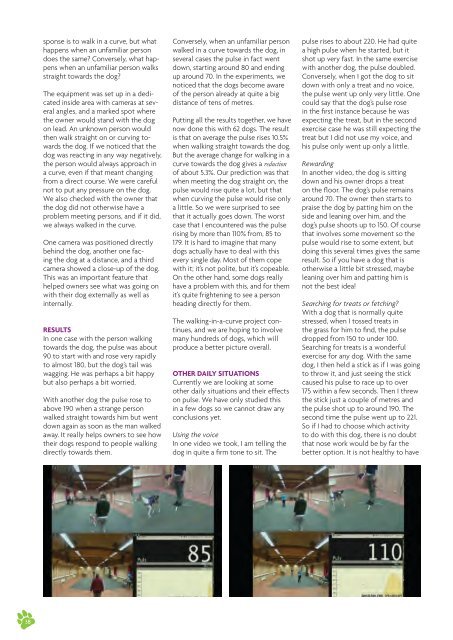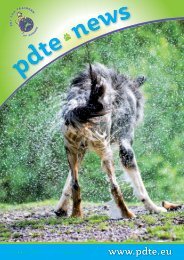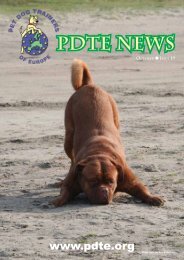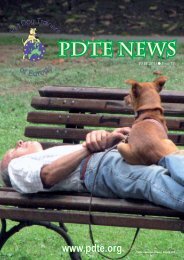PDTE 2013 Winter Newsletter
You also want an ePaper? Increase the reach of your titles
YUMPU automatically turns print PDFs into web optimized ePapers that Google loves.
sponse is to walk in a curve, but what<br />
happens when an unfamiliar person<br />
does the same? Conversely, what happens<br />
when an unfamiliar person walks<br />
straight towards the dog?<br />
The equipment was set up in a dedicated<br />
inside area with cameras at several<br />
angles, and a marked spot where<br />
the owner would stand with the dog<br />
on lead. An unknown person would<br />
then walk straight on or curving towards<br />
the dog. If we noticed that the<br />
dog was reacting in any way negatively,<br />
the person would always approach in<br />
a curve, even if that meant changing<br />
from a direct course. We were careful<br />
not to put any pressure on the dog.<br />
We also checked with the owner that<br />
the dog did not otherwise have a<br />
problem meeting persons, and if it did,<br />
we always walked in the curve.<br />
One camera was positioned directly<br />
behind the dog, another one facing<br />
the dog at a distance, and a third<br />
camera showed a close-up of the dog.<br />
This was an important feature that<br />
helped owners see what was going on<br />
with their dog externally as well as<br />
internally.<br />
RESULTS<br />
In one case with the person walking<br />
towards the dog, the pulse was about<br />
90 to start with and rose very rapidly<br />
to almost 180, but the dog’s tail was<br />
wagging. He was perhaps a bit happy<br />
but also perhaps a bit worried.<br />
With another dog the pulse rose to<br />
above 190 when a strange person<br />
walked straight towards him but went<br />
down again as soon as the man walked<br />
away. It really helps owners to see how<br />
their dogs respond to people walking<br />
directly towards them.<br />
Conversely, when an unfamiliar person<br />
walked in a curve towards the dog, in<br />
several cases the pulse in fact went<br />
down, starting around 80 and ending<br />
up around 70. In the experiments, we<br />
noticed that the dogs become aware<br />
of the person already at quite a big<br />
distance of tens of metres.<br />
Putting all the results together, we have<br />
now done this with 62 dogs. The result<br />
is that on average the pulse rises 10.5%<br />
when walking straight towards the dog.<br />
But the average change for walking in a<br />
curve towards the dog gives a reduction<br />
of about 5.3%. Our prediction was that<br />
when meeting the dog straight on, the<br />
pulse would rise quite a lot, but that<br />
when curving the pulse would rise only<br />
a little. So we were surprised to see<br />
that it actually goes down. The worst<br />
case that I encountered was the pulse<br />
rising by more than 110% from, 85 to<br />
179. It is hard to imagine that many<br />
dogs actually have to deal with this<br />
every single day. Most of them cope<br />
with it; it’s not polite, but it’s copeable.<br />
On the other hand, some dogs really<br />
have a problem with this, and for them<br />
it’s quite frightening to see a person<br />
heading directly for them.<br />
The walking-in-a-curve project continues,<br />
and we are hoping to involve<br />
many hundreds of dogs, which will<br />
produce a better picture overall.<br />
OTHER DAILY SITUATIONS<br />
Currently we are looking at some<br />
other daily situations and their effects<br />
on pulse. We have only studied this<br />
in a few dogs so we cannot draw any<br />
conclusions yet.<br />
Using the voice<br />
In one video we took, I am telling the<br />
dog in quite a firm tone to sit. The<br />
pulse rises to about 220. He had quite<br />
a high pulse when he started, but it<br />
shot up very fast. In the same exercise<br />
with another dog, the pulse doubled.<br />
Conversely, when I got the dog to sit<br />
down with only a treat and no voice,<br />
the pulse went up only very little. One<br />
could say that the dog’s pulse rose<br />
in the first instance because he was<br />
expecting the treat, but in the second<br />
exercise case he was still expecting the<br />
treat but I did not use my voice, and<br />
his pulse only went up only a little.<br />
Rewarding<br />
In another video, the dog is sitting<br />
down and his owner drops a treat<br />
on the floor. The dog’s pulse remains<br />
around 70. The owner then starts to<br />
praise the dog by patting him on the<br />
side and leaning over him, and the<br />
dog’s pulse shoots up to 150. Of course<br />
that involves some movement so the<br />
pulse would rise to some extent, but<br />
doing this several times gives the same<br />
result. So if you have a dog that is<br />
otherwise a little bit stressed, maybe<br />
leaning over him and patting him is<br />
not the best idea!<br />
Searching for treats or fetching?<br />
With a dog that is normally quite<br />
stressed, when I tossed treats in<br />
the grass for him to find, the pulse<br />
dropped from 150 to under 100.<br />
Searching for treats is a wonderful<br />
exercise for any dog. With the same<br />
dog, I then held a stick as if I was going<br />
to throw it, and just seeing the stick<br />
caused his pulse to race up to over<br />
175 within a few seconds. Then I threw<br />
the stick just a couple of metres and<br />
the pulse shot up to around 190. The<br />
second time the pulse went up to 221.<br />
So if I had to choose which activity<br />
to do with this dog, there is no doubt<br />
that nose work would be by far the<br />
better option. It is not healthy to have<br />
38

















